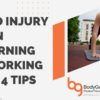It’s more common than you might think for someone to get an x-ray done for a shoulder, neck, or back problem and when the report comes back, one of the first things it lists is scoliosis. People are often left wondering what to do with this information and have questions like, “Should I be worried?” or “I’ve lived my whole life without knowing I have this, does this need to be addressed?” Usually, people are told something like, “It’s so small, it doesn’t matter” or “You’ve been living with this for years and you’ve been fine” and those answers might be true, but they don’t give you any information.
June is Scoliosis Awareness Month and many people may be shocked to discover they’ve been living with undiagnosed scoliosis. To refresh your memory, scoliosis is an abnormal curvature of the spine and it usually has no clear cause. It’s important to catch it early in children to prevent it from getting worse, but after puberty, scoliosis typically doesn’t progress much further. While scoliosis won’t necessarily cause pain in the affected area of the spine, it can put you at a higher risk for developing shoulder, hip, and neck pain when combined with other risk factors, like working a sedentary job. Whether you’re already experiencing symptoms or you want to prevent any from occurring, keep reading to learn what you can do.
1. Shoulder Pain: A hallmark of scoliosis is something called a rib hump that occurs on one side of the back. This causes the shoulder blade to stick out more on one side and alters the efficiency of the shoulder muscles that attach to it. The rib hump doesn’t need to be significant to alter your shoulder mechanics and even people with poor posture can experience ribcage stiffness that results in something similar.
The two main things you can do are maintain good ribcage mobility with an exercise like this:

And maintain strong shoulder blade stabilizing muscles with exercises like prone I’s, rows, and side-planks that target the serratus anterior and lower traps muscles. If you’re not sure how to perform these exercises or want to be sure you’re performing them correctly, come visit us at any of our 6 Chicagoland locations.
2. Hip/Knee Pain: Another hallmark of scoliosis is a difference in waist size from left to right. Stand in front of a mirror with both arms hanging down by your sides and see whether there’s a larger gap between your arm and your waist on one side. Sometimes this is caused by scoliosis but it can also be the result of a postural adaptation that can be reversed. The issue with this imbalance is it changes the amount of weight being distributed to each leg. Sometimes it can be the leg with more weight going through it that experiences hip and knee pain from overuse, but it can often be the leg with less weight going through it that experiences pain due to underuse and the muscles becoming weaker and providing less stability.
Single-leg exercises are therefore a great way to make sure both legs are getting a good workout. The single leg deadlifts pictured below are an excellent example, as are step-ups and lunges. If you don’t know what a dynamic valgus is though and how it contributes to your pain, or you’re not sure how to correct it, be sure to take advantage of our free screen to find out whether it’s a quick fix or something that will take more skilled work to overcome.
3. Neck/Back Pain: Frequently, back pain occurs at the opposite end of the spine from the scoliosis, with thoracolumbar scoliosis resulting in neck pain and vice versa. The reason is that typically the area with the greatest curve has the least mobility, which requires hypermobility from the other segments to compensate. Without enough core stability, that hypermobility goes uncontrolled and results in pain. Whether you have a true scoliosis or a posture-related imbalance, there’s a core muscle that’s often overlooked but important to address. It’s the diaphragm, which can become stretched or compressed depending on what’s happening with your spine.
To help restore balance to your core, start with a diaphragmatic breathing exercise where the goal is to have the chest and the abdomen rise and fall together, the same amount at the same time. As for core strengthening exercises, first you need to make sure you’re recruiting the right muscles before you try to strengthen them. It’s not uncommon for people to overuse their obliques and rectus muscles when trying to activate their deep core muscles (transversus abdominis) which is inefficient and reduces the effectiveness and endurance of your core. Consult with a Body Gears back expert before wasting your time trying to strengthen a muscle you’re not even turning on.
For those of you with a significant scoliosis concerned about its impact on your function or appearance, request an appointment with our scoliosis specialist, Dr. Kane Thompson, PT, DPT, ATC. His unique blend of Schroth exercises and IPA manual therapy techniques make his a holistic approach to restoring your mobility and confidence.
[/et_pb_text][et_pb_text _builder_version=”3.0.105″ saved_tabs=”all”]
Written by: Dr. Julia Melanson, PT, DPT
Edited by: April Oury, PT, MSPT, IOC, CFMT, FAAOMPT, Founder
As always, consult with your Licensed Physical Therapist for individualized advice. For those in Illinois, visit your PT immediately without a prescription or referral.
Give us a call at (877) 709-1090 for more information or fill out the contact us form and we will contact you.
Don’t forget to check out our Instagram, Facebook, and Podcasts for more great information and resources.
Copyright © 2019 by Body Gears Physical Therapy
All rights reserved. This blog or any portion thereof may not be reproduced or used in any manner whatsoever without the express written permission of the publisher except for the use of brief quotations in a review.
[/et_pb_text][/et_pb_column][/et_pb_row][/et_pb_section]






